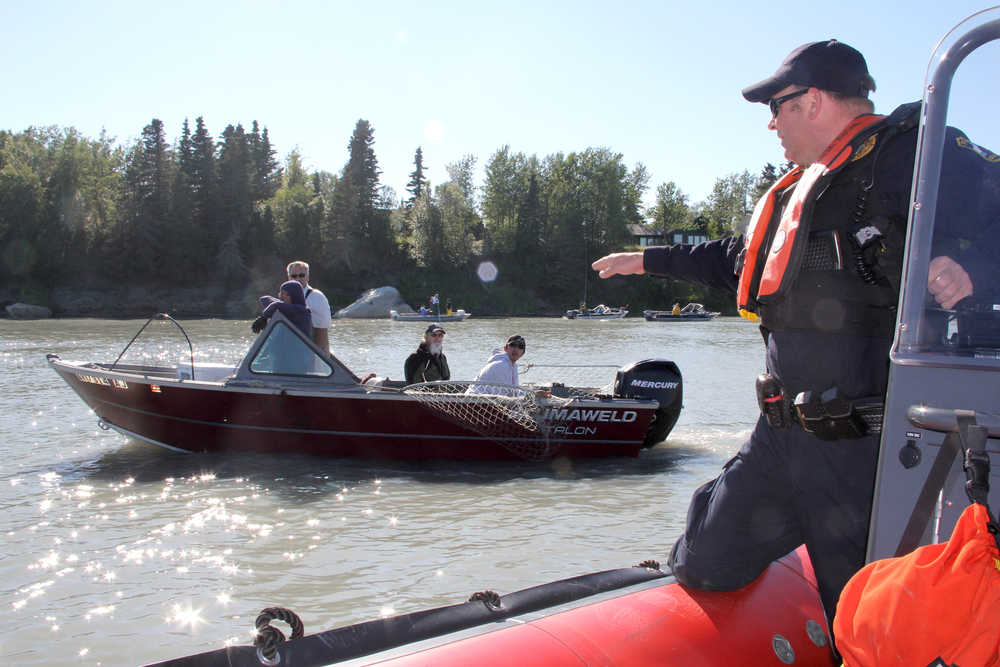With boat traffic around the mouth of the Kenai River nearing its summer peak, the City of Kenai has obtained a new rescue patrol boat that will prove to be a valuable addition to its arsenal.
The Kenai Fire Department launched a 22-foot rigid hull red inflatable boat at the start of the Kenai River dipnet season to assist in the enforcement of the no wake zone ordinance for boaters along the VIP subdivision side of the river during high tide. When the tide reaches 20.5 feet high, a flashing light is activated on three buoys to inform boaters to slow down to five miles per hour through the area.
The ordinance, passed in April by the Kenai City Council, came as a result of residents who voiced their concerns of bank erosion and property damage created from boat wakes through the mile-long river channel the length of Watergate Way.
Kenai Battalion Chief Tony Prior said the target area is patrolled only during high tide with one boat operator from the fire department and two police officers on board for enforcement. On Monday, Kenai Fire Department boat operator Courtney Lehl, escort Kenai Police Sergeant Jay Sjogren and seasonal enforcement officer Gabe Boyle took to the river and reminded boaters of the new regulation.
“Guys running fast on boats creates problems for people going upstream and downstream,” Prior said. “People are glad to see us out there because they know when you get that many people on the river there is the potential of bad things happening.”
The boat is owned by Central Emergency Services, who acquired the vessel for $108,000, with approximately $100,750 paid with a state grant, said CES Health and Safety Officer Brad Nelson. The boat replaced a 30-year-old riverboat that was housed at the Sterling CES Station, Nelson said.
The new boat is intended for deep-water operations and will be kept at the Kenai Fire Department because of its proximity to the Kenai boat launch, Nelson said.
“Having it here in a centralized location is good not only for patrols but rescues as well,” Nelson said. “So many agencies have access to it. This is an example of how we all can work together to better protect the public.”
Prior said six firefighters have taken Swiftwater Rescue Courses, a three-day training course that prepares first responders to make an effective rescue. By the end of September, the entire department will be trained.
Prior knows from personal experience how valuable a new rescue boat can be for the community. Last August a commercial fishing vessel capsized in rough seas at the mouth of the Kenai River and sent two men into the water. When the Kenai Fire Department was dispatched to respond, their boat wouldn’t start and it took 40 minutes before the fishermen were saved.
Prior said the Coast Guard has authority to navigate the Kenai River mouth waterways but nobody is stationed in the area, leaving Kenai and Nikiski as first responders. With the commercial fleet and pleasure boaters on the water all summer, he said it is important to patrol the no wake area and make sure everyone is safe.
The new boat, marked with the CES emblem, has twin-powered 115 horsepower Yamaha motors.
“This boat allows us to get out in the (Cook) Inlet and pick up more people as quick as we can,” he said. “It is designed to cut through bigger waves. It is stable and a safer ride for us.”
Prior said the department still has a 19-foot boat, a Lucas Hurricane 500 inflatable boat with a fiberglass hull they bought from the Nikiski Fire Department. The boat is 20 years old and has patches to seal the tubes, but its still a great boat, he said.
The city has requested state money to purchase a new boat, he said.
With hundreds of boats in the river mouth, Prior said it is vital that people use situational awareness. He cautions people to not operate a boat while tired or drinking alcohol and always wear a life jacket. He said when people fall into 40-degree water, they have 10 minutes to get out before their muscles freeze up. After an hour, hypothermia sets in and people are unable to function.
“When we are on the river, we can cut out 10 minutes of response time just to get the boat to the dock and get it launched in the water,” he said. “When someone is in cold water, that could be the difference between life and death.”
Reach Dan Balmer at daniel.balmer@peninsulaclarion.com

